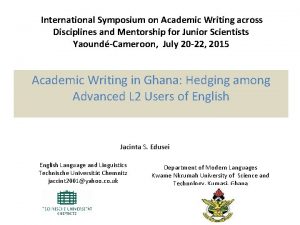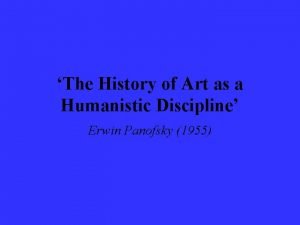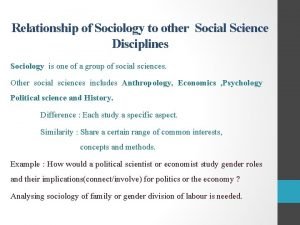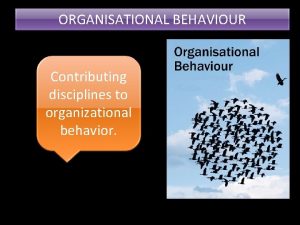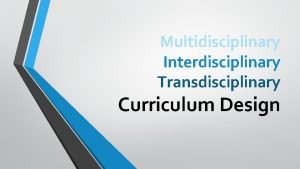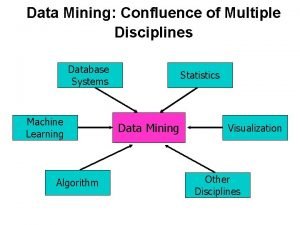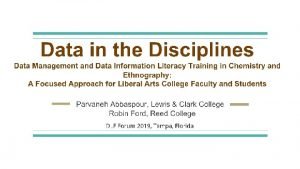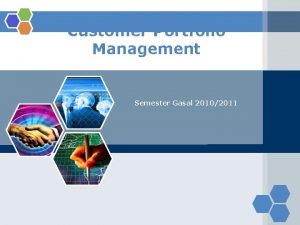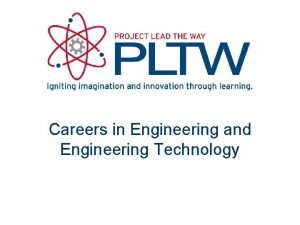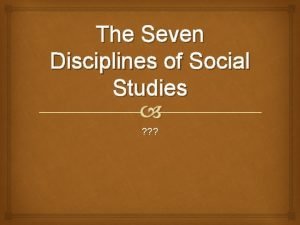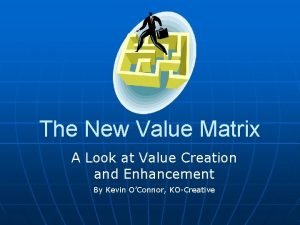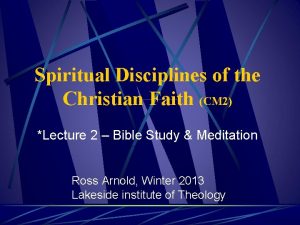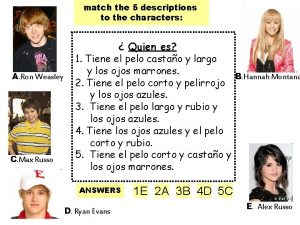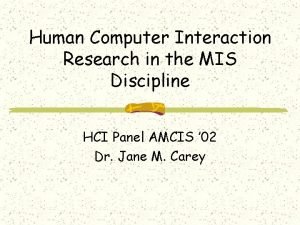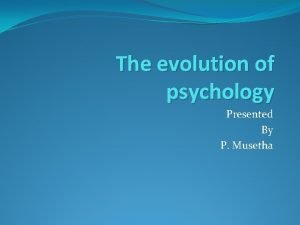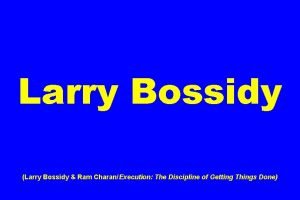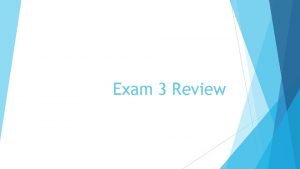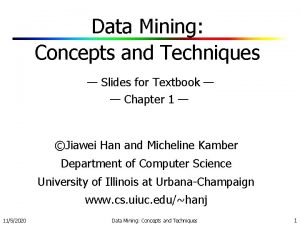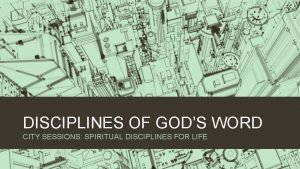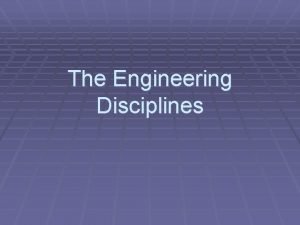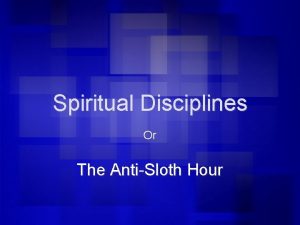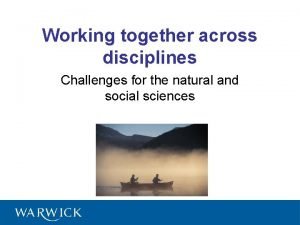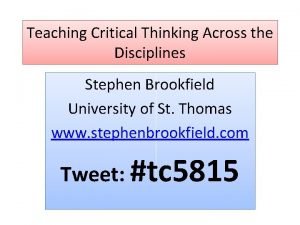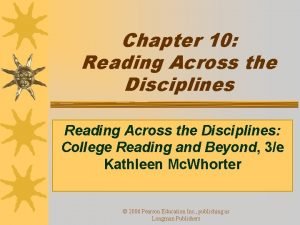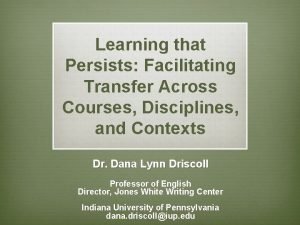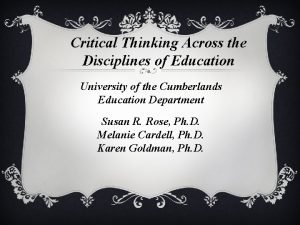Heliophysics Integrating Knowledge Across Disciplines Heliophysics Summer School

























- Slides: 25

Heliophysics: Integrating Knowledge Across Disciplines • Heliophysics Summer School • Jack Eddy Postdoctoral Fellowship Program • Living With a Star Institutes • 2 nd Eddy Cross Disciplinary Symposium In partnership with Lika Guhathakurta Heliophysics Program Scientist

History NASA’s Living With a Star Program has been partnering with UCAR’s Cooperative Programs for the Advancement of Earth System Science since 2007 to develop a new generation of heliophysicists through science-based education, training, and support for the Heliophysics community. Heliophysics Summer School Purpose: To teach the next generation of scientists about the physics of space weather events that start at the Sun and influence atmospheres, Ionospheres and the Magnetospheres throughout the solar system. • • 418 Students to date First School held in 2007 Living With a Star Institutes Jack Eddy Postdoctoral Fellowships Purpose: To train the next generation of scientists needed in the field of Heliophysics. • First class appointed in 2010 • 31 Jack Eddy Postdoctoral Fellows to date Purpose: The LWS Institute is designed to facilitate a bridge between cutting-edge heliophysics research and a societally relevant technology area that is affected by space weather. • 2015 first Institute held • 4 Institutes held to date 2

Heliophysics Summer School 3

2019 Heliophysics Summer School Highlights Heliophysics Exploration - Focus on Heliophysics System Observatory (HSO) 21 Short Student talks on topics from across the spectra of space physics research including: ● Impact of small-scale electric field variability on the ionospherethermosphere system: GITM simulation ● Outer radiation belt response to sheath regions of coronal mass ejections ● Identifying Sources of the Variable Solar Wind Through Advanced Image Processing Techniques ● Using Cube. Sats and Small. Sats to Probe HOT Plasma in the Atmosphere of a COOL Star Surprise Guest Lecturer Astronaut Dr. John Grunsfeld presented “A Conversation with an Astronaut/Scientist and Human Solar Cosmic Ray Detector” 4

Heliophysics Summer School Deans 2016 - 2020 Amitava Bhattacharjee | Princeton University Dana Longcope | University of Montana-Bozeman 2013 – 2015 Karel Schrijver | Lockheed Martin Advanced Technology Center Jan Sojka | Utah State University Frances Bagenal | University of Colorado/LASP/APS 2010 – 2012 Amitava Bhattacharjee | University of New Hampshire Dana Longcope | University of Montana-Bozeman Jan Sojka | Utah State University 2007 – 2009 Karel Schrijver | Lockheed Martin Advanced Technology Center George Siscoe | Boston University 5

Heliophysics Summer School Resources Textbooks I, III, IV & V Laboratory primers created by Goddard’s Community Coordinated Modeling Center (CCMC): ● Use the CCMC tools designed to interrogate Heliophysics models at CCMC, and ● Obtain a top-level view of the connectivity and naming of regions and parameters that comprise the heliophysics system. Additional resources, compiled from 13 years of Heliophysics Summer Schools, include: ● Textbook problem sets and solutions ● Slide presentations from lectures ● 155 Videos of lectures hosted on CPAESS You. Tube Channel 6

Heliophysics Summer School Resources NEW RELEASE Principles of Heliophysics: a textbook on the universal processes behind planetary habitability Written by Karel Schrijver et al Based on the previously published Heliophysics series, this free online volume weaves together excerpts from the original texts, organized to emphasize universal processes from a perspective that draws attention to what provides Earth (and similar (exo-)planets) with a relatively stable setting in which life as we know it can thrive. This text aims to serve as a textbook-style volume for which the original Heliophysics books are the extended "readers" with much more detail, references, and domain-specific topical chapters. This volume is intended for students in physical sciences in later years of their university training and for beginning graduate students in fields of solar, stellar, (exo-)planetary, and planetary-system sciences. New here is the inclusion of 200 "activities" in the form of problems, exercises, explorations, literature readings, and "what if" challenges. 7

2020 Heliophysics Summer School Explosive Space Weather Events and their Impacts July 14 - 21, 2020 - Boulder, CO The 2020 Summer School will focus on the foundations of Heliophysics with particular focus on transient energetic events such as solar flares, coronal mass ejections, and geomagnetic storms. The lecture series will include a core set of lectures covering the fundamentals of heliophysics and lectures devoted to the physics underlying explosive events. Additional lectures will cover the impacts these events have on life and technology, how these effects might be mitigated, and how the events might be forecast. The lectures will be supplemented with hands-on laboratory exercises that explore the fundamentals Sun-Earth system. The aim of the summer school is to provide students with the background and understanding they need to do research and make discoveries about the interconnected Heliophysics system in their professional careers. 8

Jack Eddy Postdoctoral Fellowship 9

Newly Appointed - 2019 Jack Eddy Fellows TERRY LIU Project: Magnetic reconnection at the foreshock and the space weather effects of the associated accelerated particles Host: University of Alaska, Fairbanks (Dr. Hui Zhang) WILLIAM LONGLEY Project: Investigating the nonlinear interaction between Landau damping and Coulomb collisions in Geospace plasmas Host: Rice University (Dr. Anthony Chan) ERIKA PALMERIO Project: Understanding the Evolution of the Space Weather Drivers at Earth and Mars Host: University of California, Berkeley (Dr. Christina Lee) 10

Jack Eddy Fellowship Alumni Survey Results In an effort to gather a more comprehensive set of metrics and capture the impact of the Jack Eddy Fellowship, a survey was sent out to all alumni in February 2019. Briefly describe the value/impact of your Jack Eddy fellowship experience to the scientific community? Career Development (5%) Publish: “I published 10 papers with 5 first author papers, and these papers have been cited more than 50 times now. ” Research: “I was able to contribute to the problem of particle acceleration in flares from a unique cross-disciplinary position bridging basic microphysics with solar modeling efforts. ” Publish (19%) Community (24%) Research (52%) Community: “My fellowship led to substantial impact on the scientific community, [including 7 peer-reviewed publications, numerous conference presentations, the opportunity to convening radically interdisciplinary sessions at the AGU Fall Meeting, an International Space Sciences Institute team, a successful transdisciplinary pilot program with the JPL Data Science Working Group, and] a new Working Group within the NSF Earthcube Research Coordination Network). ” 100% of all respondents felt that the Jack Eddy postdoctoral experience: ● ● Met their expectations to conduct their own research. Met their expectations to work independently. 11

Jack Eddy Fellowship Alumni Survey Results How did the Jack Eddy Fellowship enable your career success? New Collaborations: “The autonomy and excellent admin support enabled me to freely explore new collaborations outside the traditional paradigms. This capability was instrumental in the progress I was able to achieve. . . ” Career Development: “No other fellowship enables career progression with as much speed and focus. ” New Collaborations (17%) Prestige (13%) Research Independance (44%) Research Independence: “It allowed me to be independent for 2 years and pursue something that I was personally interested in. This fellowship makes this freedom possible, which is not abundant in our field and in science in general anymore. ” Career Development (26%) 12

Jack Eddy Fellowship Alumni Survey None (12%) Other Current Connections (12%) Served on Committees or Panels (36%) Received NSF Grant Funding (13%) Received NASA Grant Funding (28%) “I have served on NASA proposal review panels. I am serving as a committee member of NASA's Nexus for Exoplanet System Science (NEx. SS) Steering Council. I received three grant funding from NASA as the PI. I am a science team member of NASA's MAVEN mission. I was invited to give one 90 -minute lecture on the topic of ‘Living with Stars and Societal Relevance’ in 2018 Heliophysics Summer School. ” How you served on any NASA and/or NSF committees or panels, received grant funding from NASA and/or NSF, or have any current connections with NASA and/or NSF during the past year? Non-Profit (13%) Corporate (22%) International (17%) US Academia (39%) Federal (9%) Jack Eddy Alumni Employers 13

Living With a Star Institutes 14

Living With A Star Institutes 2015 Topic Area 2016 Topic Areas 2017 - 2018 Topic Areas Principles in relation to the effects of geomagnetically induced currents (GICs) during CME-driven geomagnetic disturbances (GMDs) ● Nowcasts of radiation storms (proton events) at energy levels that could create a radiation hazard for aircrew and passengers ● Nowcasts of atmospheric drag for LEO spacecraft ● TEC and ionospheric scintillation for GPS applications ● Prediction and specification of >10 Me. V proton flux 15

Living With A Star Institutes AMS Town Hall – Wednesday, Jan. 15, 2020 LWS Institutes: Pathways for Reducing Risk to Aviation and Satellite Operations A joint panel will discuss the current state and future directions of aviation radiation and atmospheric drag and how to better understand mitigate space weather related risks. 2018 Topic Area: TEC and ionospheric scintillation for GPS applications Space Weather Impacts on GNSS Radio Occultations at Mid-Latitudes Meetings held: ● Feb. 18 - 22, 2019 ● Sept. 30 - Oct. 4, 2019 16

2 nd Eddy Cross Disciplinary Symposium 17

The aim of the 2 nd Eddy Cross Disciplinary Symposium is to bring scientists (both early-career and more senior) together, from diverse disciplines, to help define the next decade of helio-physical research, including its implications for planetary and astrophysical objects. 18

2 nd Eddy Cross Disciplinary Symposium This Eddy Symposium will focus upon techniques for optimizing scientific return to broad questions such as: ● How do we tackle the diversity of physical conditions and multi-scale science needed to arrive at a more holistic understanding of heliophysics? ● What new threads does solar variability bring within a changed climate? Agenda Overview: Monday, June 8 - Wednesday, June 10 General session open to all attendees. Will include talks, discussions, posters, and more. Thursday, June 11 - Friday, June 12 By invitation only. The final two days will focus on discussions and workshop activities, led by the Eddy fellows, that will focus on defining important and tractable problems ripe for implementation. https: //cpaess. ucar. edu/meetings/2019/symposium-2020 19

NASA Frontier Development Laboratory 20

21

FDL Related Presentations at Fall AGU 2019 Wednesday, 11 December 2019 Time: 08: 00 - 12: 20 Location: Moscone South - Poster Hall Paper: Auto-calibration and reconstruction of SDO’s Atmospheric Imaging Assembly channels with Deep Learning Luiz Fernando Guedes dos Santos Tuesday, 10 December 2019 Location: Moscone West – 2012, L 2 Time: 12: 05 – 12: 20 Paul Wright Super-Resolution Maps of the Solar Magnetic Field Covering 40 Years of Space Weather Events Thursday, 12 December 2019 Time: 13: 40 - 18: 00 Location: Moscone South - Poster Hall Paper: Machine learning tools to produce 3 D shape models of asteroids from radar observations Michael Busch Tuesday, 10 December 2019 Locations: Moscone South - 208, L 2 Time: 14: 45 - 14: 53 Validating and Cross-Calibrating Long-term Solar Cycle Data for Driving Solar Cycle Models (Invited) Andres Munoz-Jaramillo Thursday, 12 December 2019 Location: Moscone South - Poster Hall Time: 13: 40 - 18: 00 Paper: An Overview of the NASA Frontier Development Lab 2019: An Applied Artificial Intelligence Accelerator (Invited) Paul Wright Wednesday, 11 December 2019 Location: Moscone South - Poster Hall Time: 08: 00 - 12: 20 Validating and Cross-Calibrating Long-term Solar Cycle Data for Driving Solar Cycle Models (Invited) Andres Munoz-Jaramillo 22

23

24

25
 Academic english reading and writing across the disciplines
Academic english reading and writing across the disciplines Organizational patterns in reading
Organizational patterns in reading Summer school lodi unified
Summer school lodi unified Crescenta valley high school graduation 2021
Crescenta valley high school graduation 2021 Assignment in spanish
Assignment in spanish The history of art as a humanistic discipline
The history of art as a humanistic discipline Sociology social science
Sociology social science Contributing disciplines to organisational behaviour
Contributing disciplines to organisational behaviour Interdisciplinary multidisciplinary transdisciplinary
Interdisciplinary multidisciplinary transdisciplinary Datamining
Datamining Data management disciplines
Data management disciplines Customer portfolio management definition
Customer portfolio management definition Engineering disciplines
Engineering disciplines Disciplines of social studies
Disciplines of social studies Michael treacy and fred wiersema
Michael treacy and fred wiersema 10 spiritual disciplines
10 spiritual disciplines Faith cm
Faith cm Match the descriptions to the characters
Match the descriptions to the characters Disciplines of hci
Disciplines of hci Data mining confluence of multiple disciplines
Data mining confluence of multiple disciplines Psychology's intellectual parents are the disciplines of
Psychology's intellectual parents are the disciplines of Larry
Larry The presence of spectators helps young athletes
The presence of spectators helps young athletes Data mining concepts and techniques
Data mining concepts and techniques Personal vs shared knowledge
Personal vs shared knowledge Knowledge shared is knowledge squared
Knowledge shared is knowledge squared
